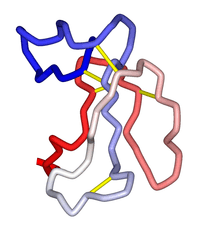Alpha-Bungarotoxin
| α-Bungarotoxin | |
|---|---|
|
Schematic diagram of the three-dimensional structure of α-bungarotoxin. Disulfide bonds shown in gold. From PDB: 1IDI. | |
| Identifiers | |
| Organism | |
| Symbol | N/A |
| CAS number | |
| UniProt | P60616 |
α-Bungarotoxin (α-BTX) is one of the bungarotoxins, components of the venom of the elapid snake the Taiwanese banded krait (Bungarus multicinctus). It is a type of α-neurotoxin, a neurotoxic protein that is known to bind competitively and in a relatively irreversible manner to the nicotinic acetylcholine receptor found at the neuromuscular junction, causing paralysis, respiratory failure, and death in the victim.[1] It has also been shown to play an antagonistic role in the binding of the α7 nicotinic acetylcholine receptor in the brain, and as such has numerous applications in neuroscience research.
Structure
α-Bungarotoxin is a 74-amino-acid, 8 kDa α-neurotoxin with five disulfide bridges that binds as a competitive antagonist to nicotinic acetylcholine receptors (nAChRs). As with other snake venom α-neurotoxins, it has a three-finger fold tertiary structure, which is a four disulfide globular core from which emerge three loops (fingers) and a C-terminal tail. The tips of fingers I and II form a mobile region that is essential for proper binding.[2]
Hydrogen bonds allow for an antiparallel β-sheet, which keeps the second and third loops roughly parallel. The three-finger structure is preserved by four of the disulfide bridges: the fifth can be reduced without loss to toxicity. The fifth bridge is located on the tip of the second loop.[3]
The multiple disulfide bonds and small amount of secondary structure seen in α-BTX is the cause of the extreme stability of this kind of neurotoxin. Since there are many entropically viable forms of the molecule, it does not denature easily, and has been shown to be resistant to boiling[4] and strong acids.[5][6]
Mechanism
α-neurotoxins antagonistically bind irreversibly to nAChRs of skeletal muscles, thereby blocking the action of ACh at the postsynaptic membrane, inhibiting ion flow and leading to paralysis. nAChRs contain two binding sites for snake venom neurotoxins.[7] Progress towards elucidation of the dynamics of binding action of these sites has proved difficult, although recent studies using normal mode dynamics[8] have aided in predicting the nature of both the binding mechanisms of snake toxins and of ACh to nAChRs.
One such study, by Samson and Levitt, 2008,[9] revealed a twist-like gating motion responsible for nAChR channel opening. The ion channel diameter was shown to increase with this motion, although neither the twist nor the increase in channel diameter was observed when the nAChR was in complex with either one or two α-bungarotoxin molecules. The twist-like motion is in agreement with time-resolved electron microscopic analysis of the acetylcholine receptor pore that shows rotation of the two α subunits upon ACh binding.[10] The observation that a single molecule of the toxin suffices to inhibit channel opening is in agreement with experimental data on the amount of toxin per receptor.[11]
Research applications
α-Bungarotoxin has played a large role in determining many of the structural details of the nicotinic acetylcholine receptors. It can be conjugated to a fluorophore or enzyme for immunohistochemical staining of fixed tissues and visualization via light or fluorescence microscopy. This application enables morphological characterization of the neuromuscular junctions.
See also
References
- ↑ Young, Howard S.; Herbette, Leo G.; Skita, Victor (August 2003). "α-Bungarotoxin Binding to Acetylcholine Receptor Membranes Studied by Low Angle X-Ray Diffraction". Biophysical Journal. 85 (2): 943–953. ISSN 0006-3495. PMC 1303215
 . PMID 12885641. doi:10.1016/s0006-3495(03)74533-0.
. PMID 12885641. doi:10.1016/s0006-3495(03)74533-0. - ↑ Moise, L.; Piserchio, A.; Basus, V. J.; Hawrot, E. (2002). "NMR Structural Analysis of alpha -Bungarotoxin and Its Complex with the Principal alpha -Neurotoxin-binding Sequence on the alpha 7 Subunit of a Neuronal Nicotinic Acetylcholine Receptor". Journal of Biological Chemistry. 277 (14): 12406–12417. PMID 11790782. doi:10.1074/jbc.M110320200.
- ↑ Love, R. A.; Stroud, R. M. (1986). "The crystal structure of alpha-bungarotoxin at 2.5 a resolution: Relation to solution structure and binding to acetylcholine receptor". Protein engineering. 1 (1): 37–46. PMID 3507686. doi:10.1093/protein/1.1.37.
- ↑ Tu, A. T.; Hong, B. S. (1971). "Purification and chemical studies of a toxin from the venom of Lapemis hardwickii (Hardwick's sea snake)". The Journal of Biological Chemistry. 246 (9): 2772–2779. PMID 5554293.
- ↑ Chiceportiche, Robert; Vincent, Jean P.; Kopeyan, Charles; Schweitz, Hugues; Lazdunski, Michel (1975). "Structure-function relation in the binding of snake neurotoxins to the Torpedo membrane receptor". Biochemistry. 14 (10): 2081–2091. doi:10.1021/bi00681a007.
- ↑ Chen, Y.H.; Tai, J.C.; Huang, W.J.; Lau, M.Z.; Hung, M.C.; Lai, M.D.; Yang, J.T. (1982). "Role of aromatic residues in the structure-function relationship of α-bungarotoxin". Biochemistry. 21 (11): 2592–2600. doi:10.1021/bi00540a003.
- ↑ Young, H. S.; Herbette, L. G.; Skita, V. (2003). "α-Bungarotoxin Binding to Acetylcholine Receptor Membranes Studied by Low Angle X-Ray Diffraction". Biophysical Journal. 85 (2): 943–953. PMC 1303215
 . PMID 12885641. doi:10.1016/S0006-3495(03)74533-0.
. PMID 12885641. doi:10.1016/S0006-3495(03)74533-0. - ↑ Levitt, M.; Sander, C.; Stern, P. S. (1985). "Protein normal-mode dynamics: Trypsin inhibitor, crambin, ribonuclease and lysozyme". Journal of Molecular Biology. 181 (3): 423–447. PMID 2580101. doi:10.1016/0022-2836(85)90230-X.
- ↑ Samson, A. O.; Levitt, M. (2008). "Inhibition Mechanism of the Acetylcholine Receptor by α-Neurotoxins as Revealed by Normal-Mode Dynamics". Biochemistry. 47 (13): 4065–4070. PMC 2750825
 . PMID 18327915. doi:10.1021/bi702272j.
. PMID 18327915. doi:10.1021/bi702272j. - ↑ Miyazawa, A.; Fujiyoshi, Y.; Unwin, N. (2003). "Structure and gating mechanism of the acetylcholine receptor pore". Nature. 423 (6943): 949–955. PMID 12827192. doi:10.1038/nature01748.
- ↑ Changeux, J.; Kasai, M.; Lee, C. (1970). "Use of a snake venom toxin to characterize the cholinergic receptor protein". Proceedings of the National Academy of Sciences of the United States of America. 67 (3): 1241–1247. PMC 283343
 . PMID 5274453. doi:10.1073/pnas.67.3.1241.
. PMID 5274453. doi:10.1073/pnas.67.3.1241.
External links
- Bungarotoxins at the US National Library of Medicine Medical Subject Headings (MeSH)
- Structure at GenBank
